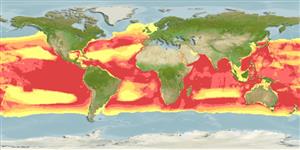Common names from other countries
Environment: milieu / climate zone / depth range / distribution range
Écologie
Pélagique; profondeur 0 - 3000 m (Ref. 83346). Tropical; 20°C - ? (Ref. 75906); 90°N - 90°S, 180°W - 180°E
Atlantic Ocean and Indo-Pacific. Tropical and subtropical.
Length at first maturity / Taille / Poids / Âge
Maturity: Lm ? range ? - ? cm Max length : 1,550 cm TL mâle / non sexé; (Ref. 1394); poids max. publié: 25.0 t (Ref. 1394)
Depth range based on reported depth in Angola (Ref. 83346). Found both offshore, near the coast in many areas (Ref. 1394) and shelf waters (Ref. 122680). Commonly in groups of 10 to 20 individuals on feeding grounds (Ref. 801). They are active lunge feeders (Ref. 1394). Known as 'gulpers,' feeding in separate events, often lunging at large schools of fish (Ref. 122680). Feeds primarily on fish, but they also take invertebrates (Ref. 1394) like krill (Ref. 122680). Oceanodromous (Ref. 75906).
Jefferson, T.A., S. Leatherwood and M.A. Webber. 1993. (Ref. 1394)
Statut dans la liste rouge de l'IUCN (Ref. 130435)
statut CITES (Ref. 108899)
Utilisations par l'homme
Pêcheries: commercial
FAO - pêcheries: landings, species profile | FishSource | Sea Around Us
Outils
Sources Internet
Estimates based on models
Preferred temperature
(Ref.
115969): 1.3 - 9.2, mean 2 (based on 18026 cells).
Vulnérabilité
Very high vulnerability (87 of 100).
Catégorie de prix
Unknown.
